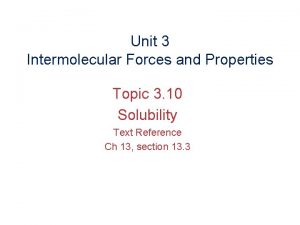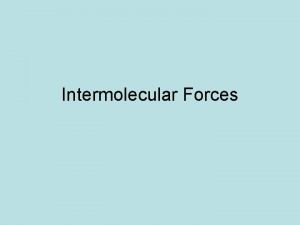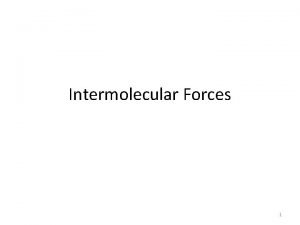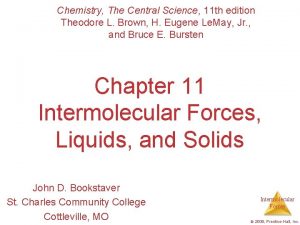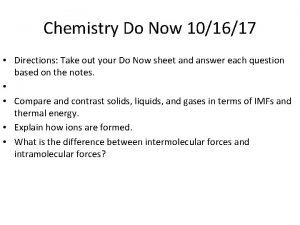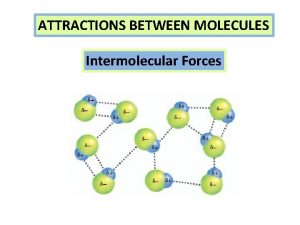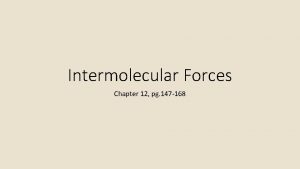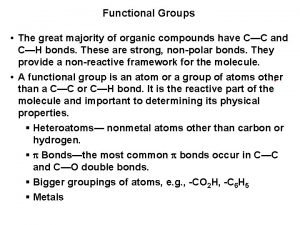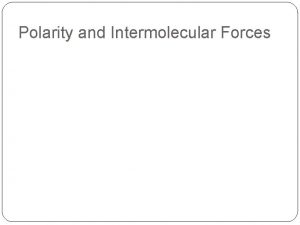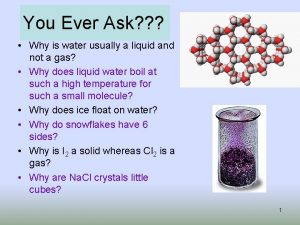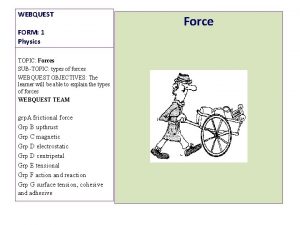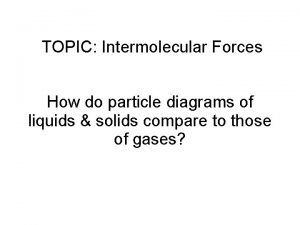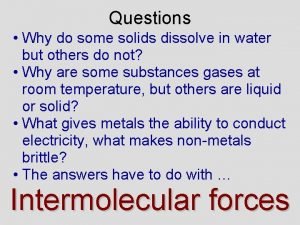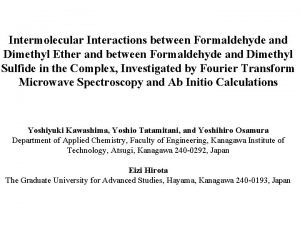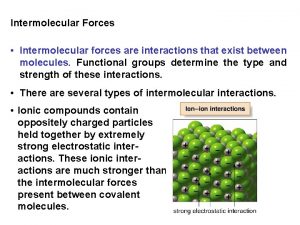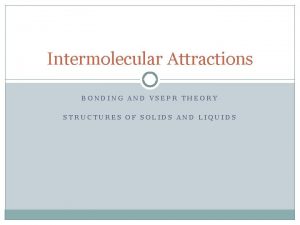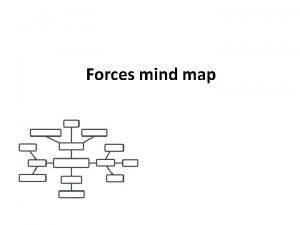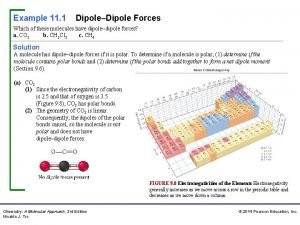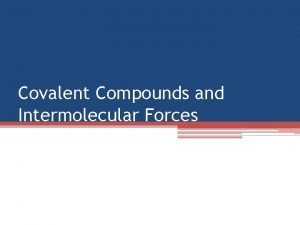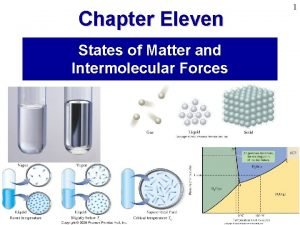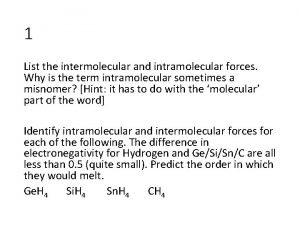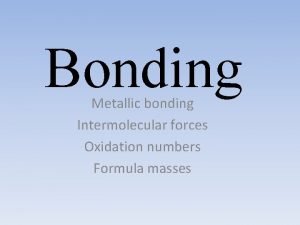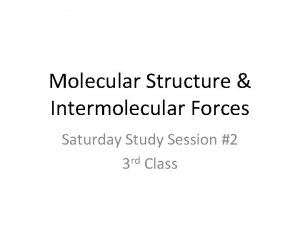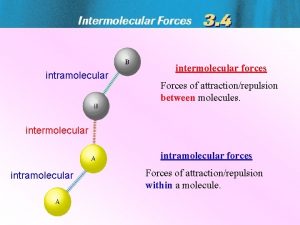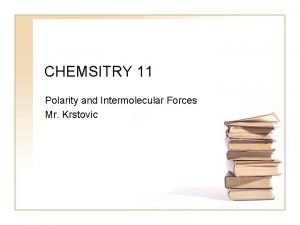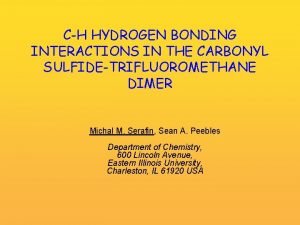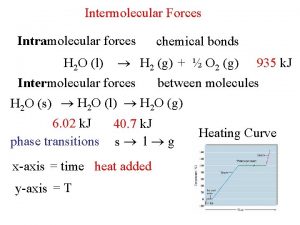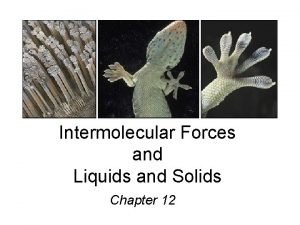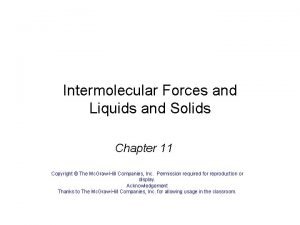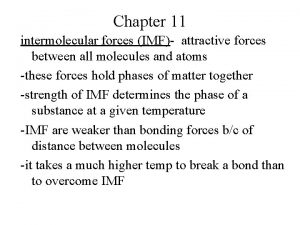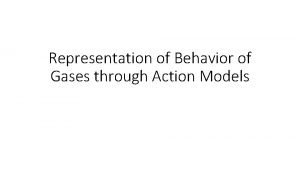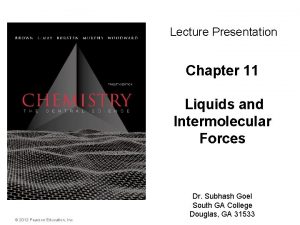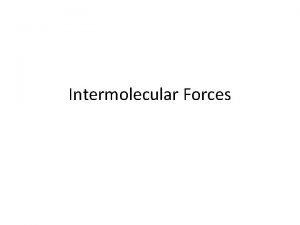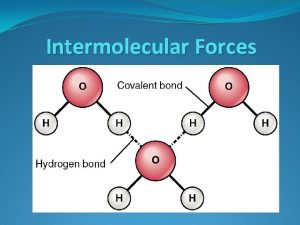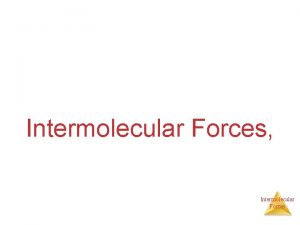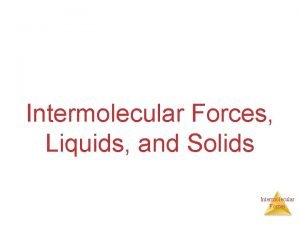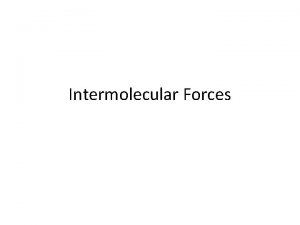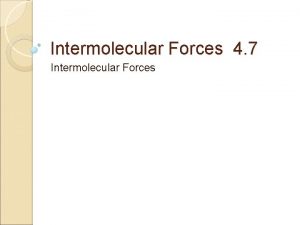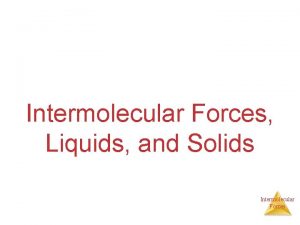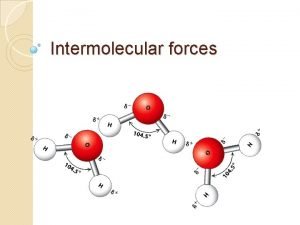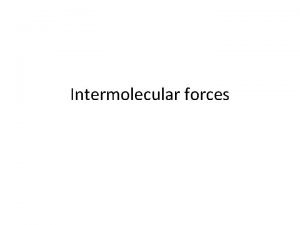Chapter 12 Intermolecular Forces and Physical Properties of


























































- Slides: 58

Chapter 12 Intermolecular Forces and Physical Properties of Liquids and Solids Dr. A. Al-Saadi 1

Preview ¢ ¢ Intermolecular forces. Properties of liquids. l ¢ Properties of solids. l l l ¢ ¢ Dr. A. Al-Saadi Vapor pressure Lattice and units cells. Closest packing. Types of crystalline solids. Changes of states. Phase diagram. 2

Chapter 12 Section 1 The Three Phases of Matter Molecules are far apart from each other, having continuous motion, and have little interactions Dr. A. Al-Saadi The motion of the molecules is slower as compared to gas, achieving a slight movement and disorder. The molecules are locked in place but can vibrate about their positions. 3

Chapter 12 Section 1 The Three Phases of Matter ¢ ¢ ¢ Density Compressibility Internal attraction forces Gas Low High Low Solid High Low High Liquid lies somehow in between, but it is closer in its structural properties to solid (Condensed phases). H 2 O(s) → H 2 O(l) → H 2 O(g) Dr. A. Al-Saadi ΔHºfus = 6. 02 k. J/mol ΔHºvap = 40. 7 k. J/mol 4

Chapter 12 Section 1 Intermolecular Forces ¢ ¢ The force holding atoms together to form a molecule is known as intramolecular force. (covalent and ionic bonding) The force holding a collection of molecules together in the condensed phases is caled intermolecular force. q The magnitude of intermolecular forces is what determines whether the particles that make up a substance are gas, liquid, or solid. Intramolecular forces >> Intermolecular forces (solid) > Intermolecular forces (liquid) > Intermolecular forces (gas) Dr. A. Al-Saadi 5

Chapter 12 Section 1 Intermolecular Forces ¢ ¢ The changes in states are due to the changes in intermolecular interaction, which increases as more energy is added. What holds atoms together is intramolecular forces. H 2 O(s) → H 2 O(l) → H 2 O(g) → 2 H(g) + O(g) Dr. A. Al-Saadi ΔHºfus = 6. 02 k. J/mol ΔHºvap = 40. 7 k. J/mol ΔHºdiss. = 934 k. J/mol 6

Chapter 12 Section 1 Types of Intermolecular Forces q q Dipole-Dipole Interaction. Hydrogen Bonding. London Dispersion Forces. Ion-Dipole Interaction. Dr. A. Al-Saadi 7

Chapter 12 Dipole-Dipole Interaction ¢ ¢ δ- Section 1 δ+ It exists as a weak electrostatic attraction between polar molecules. In a condensed state, the molecules orient themselves to maximize electrostatic attractions and minimize the electrostatic repulsions. Dipole-dipole forces is 1% as strong as covalent and ionic bonds. They become weaker as the distance between the molecules gets larger. Dr. A. Al-Saadi 8

Chapter 12 Section 1 Dipole-Dipole Interaction ¢ ¢ Dr. A. Al-Saadi The attractive forces between polar molecules depend on the magnitude of the dipole. Larger intermolecular force between the molecules requires more energy to separate between the particles and, as a result, the substance will boil at higher temperatures. 9

Chapter 12 Section 1 Hydrogen Bonding δδ+ ¢ ¢ It is associated only with small, highly electronegative atoms, especially N, O, and F atoms. Hydrogen bonds between HF molecules take place between the H atom with a large δ+ charge and a lone pair of the F atom. Dr. A. Al-Saadi HF molecule 10

Chapter 12 Section 1 Hydrogen Bonding ¢ ¢ O atoms undergo strong hydrogen bonding with H atoms in H 2 O resulting in a high boiling temperature for water. Two factors explain the strengths of hydrogen bonding: l The great polarity of the bond. l The close approach of the dipoles allowed by the smaller size of the atoms. Dr. A. Al-Saadi 11

Chapter 12 Section 1 Hydrogen Bonding Linear hydrides Bent hydrides Trigonal pyramidal hydrides Tetrahedral hydrides The boiling points of the covalent hydrides of the elements in groups 4 A, 5 A, 6 A, and 7 A Dr. A. Al-Saadi As going down a group (increase in MM), the intermolecular force increases. Exceptions are O, F and N atoms 12

Chapter 12 Section 1 Hydrogen Bonding ¢ Dr. A. Al-Saadi Nitrogen-, oxygen-, and fluorine-containing molecules exhibit hydrogen bonding between themselves or even with other molecules of the same type. 13

Chapter 12 Section 1 London Dispersion Forces ¢ ¢ It is the only force present in non-polar molecules and noble gases. The electron charge is uniformly distributed around the nucleus (electron cloud). However, an non-uniform electron distribution could develop on an atom at some instances. This would lead to instantaneous dipole within the atom, and a distorted electron density would result. Distortion of electron distribution Dr. A. Al-Saadi δ- δ+ 14

Chapter 12 Section 1 London Dispersion Forces ¢ ¢ Dr. A. Al-Saadi The instantaneous dipole in a molecule or atom can induce (polarize) similar dipole in neighboring atoms, which then can polarize the next molecules, and so on. This type of interaction is extremely weak and short-lived, yet it is especially significant for large atoms because they are more capable to be polarized. 15

Chapter 12 Section 1 London Dispersion Forces ¢ ¢ Dr. A. Al-Saadi Dispersion force is the only type of force that exists in nonpolar molecules. Dispersion force becomes more significant when the electrons are mobile within a molecule. This is found more in large size molecules (greater molar masses) 16

Chapter 12 Section 1 London Dispersion Forces in Noble Gases ¢ ¢ Dispersion force is the only type of force that exists in noble gases. The weaker the dispersion force between the atoms in a noble gas, the lower the freezing point temperature. Dr. A. Al-Saadi 17

Chapter 12 Section 1 Ion-Dipole Interactions ¢ It is shown by an attraction force between an ion (positive or negative) and a polar molecule. ¢ Cations generally interact more strongly with dipoles than anions of the same magnitude of charge because cation size is smaller Dr. A. Al-Saadi 18

Chapter 12 Section 1 Ion-Dipole Interactions ¢ Dr. A. Al-Saadi A higher charge cation interacts more strongly when compared with a lower charge cation from the same period. That is because of the magnitude of the charge and its smaller size. 19

Chapter 12 Section 1 Intermolecular Forces What type(s) of intermolecular forces exist between each of the following molecules? HI HI is a polar molecule: dipole-dipole forces. There also London dispersion forces between HI molecules. CF 4 is nonpolar: ONLY London dispersion forces. SO 2 S O O SO 2 is a polar molecule: dipole-dipole forces. There also dispersion forces between SO 2 molecules. Dr. A. Al-Saadi 20

Chapter 12 Section 2 Properties of Liquids ¢ Why does water bead as droplets when it fall down from a leave of a tree? Dr. A. Al-Saadi 21

Chapter 12 Section 2 Properties of Liquids ¢ Why does not the clip sink in water? ? Dr. A. Al-Saadi 22

Chapter 12 Section 2 Surface Tension ¢ ¢ Surface tension : Molecules on the surface will be pulled inward. This causes the surface of the liquid to tighten like an elastic film, thus minimizing its surface area. Liquids with larger intermolecular forces (such as those with polar molecules or hydrogen bonding) will have higher surface tensions. Dr. A. Al-Saadi 23

Chapter 12 Section 2 Capillary Action ¢ ¢ It is the rising of liquid in a narrow tube. l Cohesive forces (Intermolecular). l Adhesive forces (between the liquid molecules and the container’s inside wall). In a glass tube (container made of polar substances): l Water forms a concave meniscus. cohesion < adhesion l Mercury forms a convex meniscus. cohesion > adhesion Dr. A. Al-Saadi 24

Chapter 12 Section 2 Capillary Action l l Dr. A. Al-Saadi Water forms a concave meniscus. cohesion < adhesion Mercury forms a convex meniscus. cohesion > adhesion 25

Chapter 12 Section 2 Viscosity ¢ It is the measure of liquid’s resistance to flow. The higher the viscosity, the more slowly a liquid flows. l Liquids with larger intermolecular interaction tend to be more viscous. Dr. A. Al-Saadi 26

Chapter 12 Section 2 Viscosity ¢ It is the measure of liquid’s resistance to flow. The higher the viscosity, the more slowly a liquid flows. l Liquids with larger intermolecular interaction tend to be more viscous. l Liquids with more molecular complexity are highly viscous. ¢ Viscosity of a liquid typically decreases with the increase in temperature. For example, honey flows faster at higher temperatures. Gasoline (CH 3 – (CH 2)8 – CH 3) vs. Grease (CH 3 – (CH 2)25 – CH 3) Dr. A. Al-Saadi 27

Chapter 12 Section 2 Vapor Pressure ¢ Molecules in the liquid state are in a continuous motion and have a distribution of kinetic energy. ¢ T 1 < T 2 A specific amount of KE (E 1) is needed to overcome the intermolecular forces in the liquid phase. Dr. A. Al-Saadi 28

Chapter 12 Section 2 Vaporization Process l l l Dr. A. Al-Saadi Change of state from liquid to gas. Molecules escape the liquid and become gas when they have enough kinetic energy to do so. Vapor pressure is developed just above the liquid. Molecule in the liquid and vapor phases are in dynamic equilibrium 29

Chapter 12 Section 2 Vapor Pressure l As more amount of the liquid evaporates, The condensation rate (returning to the liquid state) of the molecules begins to increase. l Dr. A. Al-Saadi Dynamic equilibrium is established when the rates of evaporations and condensation are equal. (Equilibrium vapor pressure) http: //www. mhhe. com/physsci/chemistry/essentialchemistry/flash/vaporv 3. swf 30

Chapter 12 Section 2 Vapor Pressures of Some Liquids Dr. A. Al-Saadi Patmosphere = Pvapor + PHg Column Pvapor Patmosphere – PHg Column = 31

Chapter 12 Section 2 Vapor Pressures of Some Liquids Higher vapor pressure Dr. A. Al-Saadi Weaker intermolecular forces More volatile 32

Chapter 12 Section 2 Effect of Temperature on Vapor Pressures ¢ ¢ ¢ Dr. A. Al-Saadi The vapor pressure increases with the increase in T. The plot of vapor pressure vs. temperature is not linear. However, plotting the natural log of vapor pressures vs. the reciprocal of temperature gives a straight line. 33

Chapter 12 Section 2 Clausius-Clapeyron Equation Dr. A. Al-Saadi 34

Chapter 12 Section 2 Clausius-Clapeyron Equation y = mx + b y ¢ ¢ Dr. A. Al-Saadi m x b R = 8. 314 J / K ∙ mol ΔHvap is the molar heat of vaporization (J/mol) 35

Chapter 12 Section 2 Clausius-Clapeyron Equation ¢ Clausius-Clapeyron equation can be used to compare between two states of a gas. State 1 State 2 Subtracting the 2 nd equation from the 1 st equation gives: Dr. A. Al-Saadi 36

Chapter 12 Section 2 Clausius-Clapeyron Equation The vapor pressure and heat of vaporization of water at 25ºC is 23. 8 torr and 43. 9 k. J/mol, respectively. Calculate the vapor pressure of water at 50ºC. Dr. A. Al-Saadi 37

Chapter 12 Section 3 Crystal Structure ¢ Crystalline Solid: its components are highly ordered. ¢ Amorphous Solid: its components have considerable disorder. Dr. A. Al-Saadi 38

Chapter 12 Section 3 Crystal Structure ¢ ¢ Lattice structure is a 3 -D system of points (in defined positions) that make up a crystalline solid. Unit cell is the basic repeating structural unit in a lattice of a crystalline solid. Each lattice point is occupied by an atom 3 -D array of unit cells Dr. A. Al-Saadi 39

Chapter 12 Section 3 Unit Cells ¢ ¢ There are seven types of unit cells, of which the simple cubic cell is the one of the simplest shape. Each unit cell generates a characteristic lattice structure. Dr. A. Al-Saadi 40

Chapter 12 Section 3 Coordination Number in Crystalline Solids Packing spheres ¢ Dr. A. Al-Saadi Coordination number is 6 Simple cubic cell (scc) Coordination number – number of atoms (particles) surrounding a given atom in a crystal lattice. l Indicates how tightly atoms pack. l Larger coordination numbers indicate tighter packing. 41

Chapter 12 Section 3 Other Types of Unit Cells ¢ Dr. A. Al-Saadi Different ways of packing result in other types of cubic unit cells. Simple cubic cell (scc) Coordination number is 6 Body-centered cubic cell (bcc) Coordination number is 8 Face-centered cubic cell (fcc) Coordination number is 12 42

Chapter 12 Section 3 Other Types of Unit Cells Unit cell Lattice Space-filling unit cell Net no. of atoms per unit cell scc (8 × 1/8 = 1) 1 atom / unit cell bcc (8 × 1/8 + 1 = 2) 2 atoms / unit cell fcc (8 × 1/8 + 6 × 1/2 = 4) 4 atoms / unit cell Dr. A. Al-Saadi 43

Chapter 12 Section 3 Example of a Unit Cell An example of a Faced-Centered Lattice (FCC) with its units cell being shown. Dr. A. Al-Saadi 44

Chapter 12 Section 3 Closest Packing ¢ ¢ Dr. A. Al-Saadi The closest packing model describes the most efficient way to pack atoms in layers to be close to each other as much as possible. Atoms are represented as uniform, hard spheres. Each sphere occupies a depression in the upper and lower layers. These layers don’t lie directly on top of each other. 45

Chapter 12 Section 3 Closest Packing ¢ ¢ The 3 rd layer can result in two main types of packing: l ABA packing: the spheres in every other layer occupy the same vertical positions. l ABC packing: the spheres in every fourth layer occupy the same vertical positions. These arrangements have the most efficient use of the available space. Dr. A. Al-Saadi 46

Chapter 12 Section 3 The ABA Packing ¢ Dr. A. Al-Saadi The resulting structure from the ABA packing is the hexagonal close-packed (hcp) structure (Mg, Zn, Ti) The resulting unit cell is a hexagonal unit cell. 47

Chapter 12 Section 3 The ABC Closest Packing ¢ Dr. A. Al-Saadi The resulting structure from the ABC packing is the cubic close-packed (ccp) structure (Al, Ag, Ni). The resulting unit cell is a faced-centered cubic (fcc) cell. 48

Chapter 12 Section 3 Coordination Number ¢ ¢ Dr. A. Al-Saadi In both types of packing (hcp and ccp), each sphere has 12 equivalent neighboring spheres: l 6 in the same layers, l 3 in the layer above, and l 3 in the layer below. Coordination number = 12 49

Chapter 10 Section 4 Volume of Unit Cells Unit cell Lattice Space-filling unit cell No. of atoms per unit cell (8 × 1/8 = 1) 1 atom / unit cell (8 × 1/8 + 1 = 2) 2 atoms / unit cell (8 × 1/8 + 6 × 1/2 = 4) 4 atoms / unit cell Dr. A. Al-Saadi 50

Chapter 12 Section 3 Volume of Unit Cells ¢ ¢ The relationship between the edge length (a) and radius (r) of atoms in a unit cell can be expressed. Simple Cubic Cell a = 2 r Volume = a 3 = 8 r 3 Dr. A. Al-Saadi a r 51

Chapter 12 Section 3 Volume of Unit Cells ¢ Body-Centered Cubic Cell c = 4 r b 2 = a 2 + a 2 c 2 = a 2 + b 2 c 2 = a 2 + 2 a 2 = 3 a 2 = 16 r 2 a = 4 r/√ 3 Volume = 64 r 3/(3)3/2 Dr. A. Al-Saadi c b a r 52

Chapter 12 Section 3 Volume of Unit Cells ¢ Face-Centered Cubic Cell a 2 + a 2 = b 2 b = 4 r b 2 = 16 r 2 2 a 2 = 16 r 2 a 2 = 8 r 2 a = r√ 8 Volume = a 3 = 83/2 r 3 Dr. A. Al-Saadi b a r 53

Chapter 12 Section 3 How Do We Know the Structures of Crystals ¢ X-ray diffraction instrument can be used to analyze the structure of various chemical solid materials. Diffraction pattern Dr. A. Al-Saadi 54

Chapter 12 Section 3 X-Ray Diffraction ¢ Dr. A. Al-Saadi Diffraction is the scattering of light beams from a regular array of points in which the spacings (d) between the components are comparable with the wavelength of the light (λ). The angle of incident / reflection is given by (θ). 55

Chapter 12 Section 3 X-Ray Diffraction ¢ X-rays scattered from two different atoms may: (a) reinforce (constructive interference), or (b) cancel (destructive interference) one another. ¢ The difference in distances traveled is an integral number (n) of wavelength (λ). The diffraction pattern can be used to determine the interatomic distances. 56 ¢ Dr. A. Al-Saadi

Chapter 12 Section 3 X-Ray Diffraction xy + yz = nλ xy + yz = 2 d sinθ = nλ Dr. A. Al-Saadi (In-phase light) (From trigonometry) (Bragg Equation) 57

Chapter 12 Section 3 X-Ray Diffraction A topaz crystal has an interplanar spacing of 1. 36 Å. Calculate the wavelength of the X ray that should be used if the θ is 15. 0º. Assume n =1. 2 d sinθ = nλ Dr. A. Al-Saadi 58
 Unit 3 intermolecular forces and properties
Unit 3 intermolecular forces and properties Intramolecular forces vs intermolecular
Intramolecular forces vs intermolecular Intermolecular forces ranked
Intermolecular forces ranked Inter vs intramolecular forces
Inter vs intramolecular forces Intermolecular and intramolecular forces
Intermolecular and intramolecular forces Geckos and intermolecular forces
Geckos and intermolecular forces Similarities of intermolecular and intramolecular forces
Similarities of intermolecular and intramolecular forces Viscosity and intermolecular forces
Viscosity and intermolecular forces Capillary action intermolecular forces
Capillary action intermolecular forces Intermolecular forces are attractions between
Intermolecular forces are attractions between Interatomic and intermolecular forces
Interatomic and intermolecular forces Vapor pressure and intermolecular forces
Vapor pressure and intermolecular forces Electronegativity intermolecular forces
Electronegativity intermolecular forces Intermolecular forces of functional groups
Intermolecular forces of functional groups Polarity and intermolecular forces
Polarity and intermolecular forces Chemical property of water
Chemical property of water London dispersion forces induced dipole
London dispersion forces induced dipole Forces webquest
Forces webquest Imf
Imf 3 types of intermolecular forces
3 types of intermolecular forces Concept of imfa
Concept of imfa How intermolecular forces affect solvation
How intermolecular forces affect solvation London dispersion forces induced dipole
London dispersion forces induced dipole Pvc intermolecular forces
Pvc intermolecular forces Dimethyl ether dipole dipole
Dimethyl ether dipole dipole Intermolecular forces symbol
Intermolecular forces symbol Intermolecular forces
Intermolecular forces Strengths of intermolecular forces
Strengths of intermolecular forces 3 types of intermolecular forces
3 types of intermolecular forces Strongest to weakest intermolecular forces
Strongest to weakest intermolecular forces Ionic forces of attraction
Ionic forces of attraction Ch2cl intermolecular forces
Ch2cl intermolecular forces Hydrogen bond is intermolecular forces
Hydrogen bond is intermolecular forces Mind map about friction
Mind map about friction Ch2cl intermolecular forces
Ch2cl intermolecular forces Coh2 intermolecular forces
Coh2 intermolecular forces Intermolecular forces of matter
Intermolecular forces of matter Types of van der waals forces
Types of van der waals forces Ap chemistry intermolecular forces
Ap chemistry intermolecular forces List of intermolecular forces
List of intermolecular forces Reading forces you to be quiet
Reading forces you to be quiet Hcn bonding pairs
Hcn bonding pairs Metallic bond formula
Metallic bond formula No- structure
No- structure Sucrose intermolecular forces
Sucrose intermolecular forces Hco2h intermolecular forces
Hco2h intermolecular forces Intramolecular vs intermolecular forces
Intramolecular vs intermolecular forces Ch5n intermolecular forces
Ch5n intermolecular forces Carbonyl sulfide intermolecular forces
Carbonyl sulfide intermolecular forces Surface tension intermolecular forces
Surface tension intermolecular forces Dipole dipole bond
Dipole dipole bond Intermolecular forces
Intermolecular forces Summary of intermolecular forces
Summary of intermolecular forces Surface tension intermolecular forces
Surface tension intermolecular forces Intermolecular forces
Intermolecular forces Poem about intermolecular forces
Poem about intermolecular forces Capillary action
Capillary action Intermolecular forces london dispersion
Intermolecular forces london dispersion Van der waals forces diagram
Van der waals forces diagram
